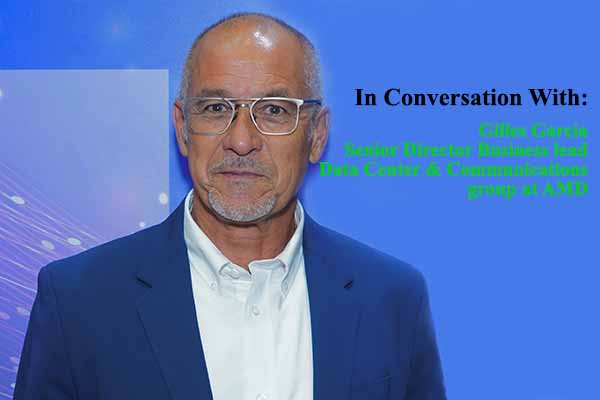5G has the potential to unleash limitless possibilities and drive innovation. Businesses can start leveraging 5G to transform business operations, disrupt competition and outpace rivals, and even unleash innovation. TimesTech spoke with Gilles Garcia, Senior Director Business lead Data Center & Communications group at AMD to learn about the AMD collaboration with government and companies, market and environment for 5G, AMD’s support and solutions and much more.
Read the full interview here:
TimeTech: Is AMD collaborating with companies or governments on 5G network adoption in India?
Gilles: As AMD showcased at India mobile Congress 2022, we are deeply involved with the companies and the 5G ecosystem in India. We are also working with the Indian government with our large presence especially in R&D in the country. At IMC 2022 we show we were collaborating very closely with some major Indian companies on their 5G solutions and rollout. In our booth, we had Radios from Mavenir, Tejas/TCS, WISIG, and we had joint demonstrations with Radisys, VVDN, and this was to publicly display the multiple cases of our close cooperation with the partners in India, at IMC 2022.
Our IMC 2022 theme was ‘Accelerating 5G Networks in India’. Several ministries stopped into our booth, including the minister of telecommunication who spent a good amount of time looking at ingenious (‘MADE in INDIA’) solutions demonstrated in the AMD booth.
TimeTech: As an industry expert, how do you evaluate the market and environment for 5G network adoption in India compared to other countries?
Gilles: 5G Deployment started several years ago in China, NA, and Korea, and started in the past 18 months in many other places in the world. So India is not in the first group. But India is taking an approach to use the 5G deployment as a way to raise its economy and its population reach; meaning the Indian government is planning to use the 5G network to drive its digital transformation by bringing the 5G network to most of its population so they can develop present and future businesses, reach out new customers, deliver remote education service to all over the country so the local communities can benefit.
It is a political decision for the social economy. In other countries, it is more driven by operators to attract new customers and less by government programs. The timeline of the 5G rollout in India is very aggressive compared to other countries of general cases and it should put India as one of the largest cases of 5G network deployments in the World in the next 12-24 months.
TimeTech: How can businesses or organizations modernize their networks to maximize 5G opportunities?
Gilles: 5G is definitely bringing new opportunities for organizations and businesses in terms of end-user reach and experience. The 5G network is not only more reliable and has higher performance and lower latency than 4G, but it allows the applications running on top of the network to develop new services delivering immersive experiences, cloud gaming and some more social focus applications such as remote health care, remote education and etc. The new capabilities offered by the 5G private network would allow organizations to improve their productivity, add more flexibility in their production tools, use a single network to drive their separate services including Network Slicing, and deliver new support capabilities such as utilizing VR and AR-based immersive solutions.
TimeTech: What solutions and support does AMD provide for telecom service providers (COSPs) to build or use 5G networks?
Gilles: As a technology and platform leader, AMD works with a large variety of Operators including Telco service providers to support them and their solution partners to leverage AMD technologies to their best capabilities. We also support them to reduce their TCO (Total Cost of Ownership) by optimizing their power consumption while increasing their performance. Our solutions to ‘COSPs’ cover from Mega-Data Centers to Edge Data Centers, and from Core/optical Network infrastructure to Access Networks, especially 5G Radio Access Networks (RAN).
TimeTech: Which strategic products or solutions AMD would like to focus on in the Indian market? Why do you see it that way?
Gilles: As we discussed, we are seeing 5G as one of the most promising markets for AMD in India, but this is not the only one. Aero Space and Defense, Automotive, and Data Centers are other markets in which we are deeply involved in India as well. India as an economical country is rising and driving ingenious solutions, we have one of the best Adaptive Computing technology portfolios in the industry, so it is making a lot of sense for AMD to support Indian companies, businesses, and government to move forward.
TimeTech: What are AMD’s Adaptive Computing Solutions? What advantage do you have over your competitors?
Gilles: Our Adaptive Computing solutions can address a lot of different markets with optimized solutions for each of them. In the 5G infrastructure, we have very strong 5G Radio solutions based on the RFSOC family which drive high integration to optimize power/performance and cost to help radio vendors to deliver leading-edge innovation products to support India’s 5G rollout. AMD, as a technology platform company, is highly focused on delivering innovative and leadership products: Power optimized / Performance optimum / Flexibility.
TimeTech: Recently, the importance of a solution that minimizes the environmental impact and lowers the operating cost in building and operating a large server or network is increasing. What is AMD working towards sustainability and energy efficiency?
Gilles: Sustainability, energy efficiency, and power-optimized, all are critical focuses for AMD and we are trying our best effort to combine performance and possibility. As leaders in the semiconductor industry, AMD embraces the responsibility to protect our planet and the opportunity to help others save energy and reduce GHG emissions.
Our approach to environmental sustainability is based on three pillars:
- MINIMIZING environmental impacts at AMD and in our supply chain
- ADVANCING environmental performance for IT users; and
- INNOVATING on collaborative solutions to address environmental challenges
TimesTech: How are major cloud players leveraging AMD’s adaptive computing solutions?
Gilles: AMD is working extensively with Hyperscalers and Cloud Providers providing a wide of instances optimised for a variety of different workloads giving customers additional choice as to how they consume resources. One example being the launch of Confidential Compute offerings based on AMD Secure Encrypted Virtualization (SEV) which helps customers secure their sensitive data without the application needing to be rewritten to recognize it is within an enclave.















